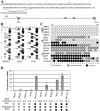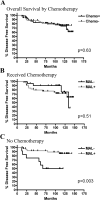Inactivation of the MAL gene in breast cancer is a common event that predicts benefit from adjuvant chemotherapy
- PMID: 19208741
- PMCID: PMC2700346
- DOI: 10.1158/1541-7786.MCR-08-0314
Inactivation of the MAL gene in breast cancer is a common event that predicts benefit from adjuvant chemotherapy
Abstract
Dysregulation of MAL (myelin and lymphocyte protein) has been implicated in several malignancies including esophageal, ovarian, and cervical cancers. The MAL protein functions in apical transport in polarized epithelial cells; therefore, its disruption may lead to loss of organized polarity characteristic of most solid malignancies. Bisulfite sequencing of the MAL promoter CpG island revealed hypermethylation in breast cancer cell lines and 69% of primary tumors analyzed compared with normal breast epithelial cells. Differential methylation between normal and cancer DNA was confined to the proximal promoter region. In a subset of breast cancer cell lines including T47D and MCF7 cells, promoter methylation correlated with transcriptional silencing that was reversible with the methylation inhibitor 5-aza-2'-deoxycytidine. In addition, expression of MAL reduced motility and resulted in a redistribution of lipid raft components in MCF10A cells. MAL protein expression measured by immunohistochemistry revealed no significant correlation with clinicopathologic features. However, in patients who did not receive adjuvant chemotherapy, reduced MAL expression was a significant predictive factor for disease-free survival. These data implicate MAL as a commonly altered gene in breast cancer with implications for response to chemotherapy.
Figures





Similar articles
-
Epigenetic silencing of MAL, a putative tumor suppressor gene, can contribute to human epithelium cell carcinoma.Mol Cancer. 2010 Nov 22;9:296. doi: 10.1186/1476-4598-9-296. Mol Cancer. 2010. PMID: 21092172 Free PMC article.
-
Elevated MAL expression is accompanied by promoter hypomethylation and platinum resistance in epithelial ovarian cancer.Int J Cancer. 2010 Mar 15;126(6):1378-89. doi: 10.1002/ijc.24797. Int J Cancer. 2010. PMID: 19642140
-
T-lymphocyte maturation-associated protein gene as a candidate metastasis suppressor for head and neck squamous cell carcinomas.Cancer Sci. 2009 May;100(5):873-80. doi: 10.1111/j.1349-7006.2009.01132.x. Cancer Sci. 2009. PMID: 19445022 Free PMC article.
-
Repression of MAL tumour suppressor activity by promoter methylation during cervical carcinogenesis.J Pathol. 2009 Nov;219(3):327-36. doi: 10.1002/path.2598. J Pathol. 2009. PMID: 19662663
-
Expression of MAL and MAL2, two elements of the protein machinery for raft-mediated transport, in normal and neoplastic human tissue.Histol Histopathol. 2004 Jul;19(3):925-33. doi: 10.14670/HH-19.925. Histol Histopathol. 2004. PMID: 15168355 Review.
Cited by
-
Research advances of MAL family members in tumorigenesis and tumor progression (Review).Mol Med Rep. 2024 Apr;29(4):57. doi: 10.3892/mmr.2024.13181. Epub 2024 Feb 16. Mol Med Rep. 2024. PMID: 38362940 Free PMC article. Review.
-
Methylation profiling of ductal carcinoma in situ and its relationship to histopathological features.Breast Cancer Res. 2014 Oct 21;16(5):423. doi: 10.1186/s13058-014-0423-9. Breast Cancer Res. 2014. PMID: 25331261 Free PMC article.
-
Epigenetic silencing of MAL, a putative tumor suppressor gene, can contribute to human epithelium cell carcinoma.Mol Cancer. 2010 Nov 22;9:296. doi: 10.1186/1476-4598-9-296. Mol Cancer. 2010. PMID: 21092172 Free PMC article.
-
Global identification of genes targeted by DNMT3b for epigenetic silencing in lung cancer.Oncogene. 2015 Jan 29;34(5):621-30. doi: 10.1038/onc.2013.580. Epub 2014 Jan 27. Oncogene. 2015. PMID: 24469050
-
Validation of DNA promoter hypermethylation biomarkers in breast cancer--a short report.Cell Oncol (Dordr). 2014 Aug;37(4):297-303. doi: 10.1007/s13402-014-0189-1. Epub 2014 Aug 16. Cell Oncol (Dordr). 2014. PMID: 25123395
References
-
- Santini V, Kantarjian HM, Issa JP. Changes in DNA methylation in neoplasia: pathophysiology and therapeutic implications. Annals of internal medicine. 2001;134:573–86. - PubMed
-
- Szyf M, Pakneshan P, Rabbani SA. DNA demethylation and cancer: therapeutic implications. Cancer letters. 2004;211:133–43. - PubMed
-
- Dulaimi E, Hillinck J, Ibanez de Caceres I, Al-Saleem T, Cairns P. Tumor suppressor gene promoter hypermethylation in serum of breast cancer patients. Clin Cancer Res. 2004;10:6189–93. - PubMed
-
- Momparler RL. Cancer epigenetics. Oncogene. 2003;22:6479–83. - PubMed
-
- Graff JR, Herman JG, Myohanen S, Baylin SB, Vertino PM. Mapping patterns of CpG island methylation in normal and neoplastic cells implicates both upstream and downstream regions in de novo methylation. The Journal of biological chemistry. 1997;272:22322–9. - PubMed
Publication types
MeSH terms
Substances
Grants and funding
LinkOut - more resources
Full Text Sources
Medical
Research Materials

